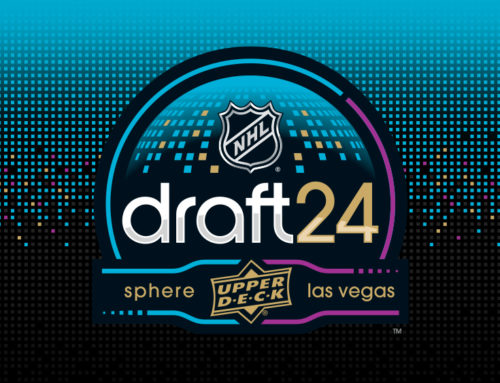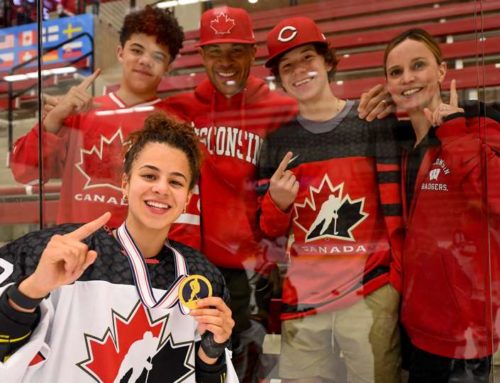Prospect Ramblings: Lessons Learned From Ranking the 2022 Draft Class
Ben Gehrels
2023-04-06
Welcome back to my weekly ramblings, where I will provide news and updates, highlight intriguing prospects, and generally track the development of junior players across the hockey world.
For the last few years, I have privately assembled my own draft rankings. They are an amalgamation of a ton of footage, scouting reports, data tracking projects, historical comparables, and draft rankings and guides. Anything that gives me a better sense of how players play and approach the game. Coming from a strictly fantasy perspective, I generally bump up players with high point ceilings and am a bit lower on prospects who look like they will be better real-life players than fantasy assets.
Because I am not a scout and rely more on data and secondhand reports than visually assessing and breaking down players’ specific skillsets myself, I have so far refrained from publishing these rankings while I continue to explore the industry and hone my assessments. Regardless, as the 2023 draft approaches, I thought it would be interesting to return to my 2022 rankings to determine which players now appear to have been ranked too low or too high. My aim is to apply these insights to players from the 2023 class to make fewer mistakes and do a better job identifying which young players to target for fantasy come June.
This week, I’ll take a look at three players from 2022 that I was most wrong about and compare them to 2023-eligibles who have a similar profile. But first, here is the Top 32 I settled on ahead of the draft last June:
With the benefit of a year of hindsight, here are some early adjustments I would make:
Too High
Jonathan Lekkerimaki (10 → 23)
Joakim Kemell (7 —> 15)
Danila Yurov (12 —> 20)
Jagger Firkus (13 —> 19)
Too Low
David Jiricek (9 → 3)
Jimmy Snuggerud (25 → 11)
Jiri Kulich (22 → 14)
Lane Hutson (20 —> 4)
——–
Too High: Jonathan Lekkerimaki (VAN)
My Ranking: 10th
Actually Drafted: 15th
Revised: 23rd
How did a player I had ranked in my top ten end up sliding almost entirely out of the first round in less than a year? Many of his peers took significant steps forward while Lekkerimaki struggled mightily transitioning from the junior-level J20 Nationell—where he scored 20 goals and added 15 assists in only 26 games—to the pro-level Allsvenskan (three goals, six assists in 29 games).
I was wowed by the goal totals and really, really liked the power and variety of his shots. His high-end shooting ability stood out to me as a defining feature, an exceptional weapon that many of his peers, including fellow Swedes Liam Ohgren (MIN) and Noah Ostlund (BUF), lacked. That was enough to rank him as highly as I did. I felt Lekkerimaki was not too far behind Alexander Holtz at the same age and felt inclined to gamble on the potential of him becoming a high-end sniper.
The issue with giving Lekkerimaki such a high ranking based primarily on a single skill is that he was not as well-equipped as others to progress to the next level. Against more capable defenders who gave him less space to work with, Lekkerimaki struggled to use his shot effectively. Taking away his shot seemed to neutralize his effectiveness in general.
It’s still early in his development to say anything for sure, but Lekkerimaki will need to have an excellent 2023-24 to re-establish himself as a high-end fantasy asset. As Dave Hall assures us in his most recent DP profile update, “there is no need to hit the panic button.” But unless you can get fair value, this is not the time to trade him. Just hold him for now and hope his value returns to closer to what it was last June.
Lessons
Lekkerimaki is a reminder to take junior production—like his near goal-per-game pace in the J20—with a grain of salt, and try to consider the team and league contexts as much as possible. Kyle Pereira (Last Word on Sports) recently reinforced the importance of this approach by suggesting that Alexis Lafreniere’s value was overinflated in his draft year by playing in the high-scoring QMJHL.
Although Lekkerimaki’s 20 goals in 26 games sound impressive, that is only the 56th-highest U18 goal total in league history. Meanwhile, his teammate, Liam Ohgren, outscored him by a significant margin, posting 33 goals in 30 games, the highest U18 total in league history. Yet I still valued Lekkerimaki over Ohgren due to my perception of the latter’s strong-but-not-dynamic two-way skillset. That assessment might still turn out to be accurate in the end, but both players have fallen for now in my updated rankings—largely because others have surpassed them.
The flipside of bumping the value of prospects who have one particular high-end skill is that that skill can cover up deficiencies that are less apparent at lower levels, such as lacking instincts or timing. Those were two red flags on Lekkerimaki in his draft-year season, especially early on. With how hard it is to find open ice at the highest level, a high-end shot is not enough on its own to ensure a player with eventually excel in the NHL.
2023 Comparables: Brayden Yager & Koehn Ziemmer
Like Lekkerimaki, Yager and Ziemmer have other strengths but are known primarily for their shooting ability. Yager went a goal-per-game for Canada at the Hlinka Gretzky Cup but actually turned in an assist-heavy 78 points in 67 WHL games this year (28 goals vs. 50 assists). He played a key role in two of his teammates reaching the 40-goal mark, one of which was Jagger Firkus (SEA), who is also known for his high-end shot. So did Yager’s team context require him to become a playmaker or did he naturally gravitate in that direction? Last year in his D-1 campaign, he scored six more goals in four fewer games than this year, which is a bit unusual for a top-of-the-draft sniper-type prospect. Ziemmer also had more assists (48) than goals (41), scoring 89 points in only 68 WHL games, but his ratio was more balanced than Yager’s.
Here is how their manually tracked microstats break down:
Once considered a top name in this draft, Yager’s stocks have fallen somewhat due to his average skating and commitment to defence. Although he had a great year points-wise, observers perhaps expected more from him given his near point-per-game campaign in his D-1. Plus, his lack of offensive zone puck retrievals and poor defensive plays vs Corsi Against ratio show that he is currently a liability in his own end. Despite the numbers above, Yager will likely be taken above Ziemmer—perhaps still as early as the top ten and likely not lower than the top 15.
Ziemmer is considered more of a mid-to-late first-round pick. He too is only an average skater—which shows up in his unimpressive transition impact—and sometimes lacks the creative playmaking that would make him more of a dual threat and create more space for himself to use his dangerous shot.
Numbers never tell the whole story, of course, but of these two, I think Yager has the higher potential of becoming this year’s Lekkerimaki. Ziemmer, on the other hand, feels like an underrated gem who might still be on the board towards the end of the second round in most fantasy drafts—depending on the size of your league.
Too Low: Jimmy Snuggerud (STL)
My Ranking: 26th
Actually Drafted: 23rd
Revised: 11th
In his Draft year with the USDP, Snuggerud showed flashes of the high-end skill we have seen from him this year in college. His main issue was consistency. His EP draft report repeatedly qualified its praise for Snuggerud’s skillset by pointing out how his deception and dynamism only ever appeared “in flashes.” The main snapshot I had of him leading up to the draft was that he was an incredible support player with high-end hockey sense and passing ability who made everyone around him better—a solid but not top-of-the-roster fantasy asset.
Or so it seemed. This year, he led his U of Minnesota squad in scoring most of the year, finishing with an impressive 50 points in 38 games, narrowly edged out by teammate Logan Cooley (57 in 37). The two freshmen finished third and fifth in the nation by points per game, behind only Adam Fantilli (2023-eligible) amongst first year players. That’s very impressive stuff for someone taken at the tail end of the first round just last year.
Despite finishing sixth in scoring on the loaded 2021-22 edition of the USDP, Snuggerud and his 50 points as an NCAA freshman outstripped former teammates Cutter Gauthier (PHI, 37 points), Rutger McGroarty (WPG, 38), and Isaac Howard (TBL, 17)—even though all three were drafted ahead of him last June. Plus, tracking stats show that his offensive (98th percentile) and transition (98th) impacts are off the charts. Even though he was used by Minnesota in an offence-first role, he still had a respectable impact on defence as well (61st).
Lessons
As stated above, there were clues that this breakout was coming: Snuggerud had dynamic skill but lacked consistency. Cooley, Frank Nazar, and company soaked up a ton of opportunity and pushed Snuggerud into more of a support role with the USDP. Heavy minutes in a top-line scoring role at Minnesota this year was just the ticket for him to turn those flashes into a steady stream.
We have seen similar spikes in development before when players are finally given opportunities to produce. Connor McMichael (WAS) and Luke Evangelista (NAS), for instance, both toiled in depth roles for the OHL London Knights during their draft years and then exploded in their D+1s when given exposure on the top line.
So who could be this year’s Snuggerud?
2023 Comparables: Ryan Leonard & Calum Ritchie
Leonard and Ritchie are two players who fit the bill—although I could see arguments for Dalibor Dvorsky and Nate Danielson too. All four have solid floors, great two-way ability, and tease with flashes of dynamic skill. The key will be determining what is currently causing their offensive inconsistencies; if it seems to boil down to the role they played this year, then we could see a Snuggerud-esque evolution into top-tier territory if their team context changes.
Leonard played a more prominent role on this year’s UNDP squad than Snuggerud did on last year’s because the 2022-23 had a Big Four (Will Smith, Oliver Moore, Gabe Perrault, Leonard) whereas 2021-22 had a Big Seven (Cooley, Nazar, Hutson, Gauthier, Snuggerud, McGroarty, Howard). That enhanced opportunity meant higher scoring totals across the board this year: in fact, Leonard’s 76 points in 49 games bested Logan Cooley’s mark of 75 points in 51 games. Does that mean we can expect him to put up 57 points in 37 games as a NCAA Freshman like Cooley did? Personally, I doubt it.
It would not be a surprise, however, to see him to exceed the point-per-game mark at BU next year. Like a Chess Master, Leonard excels at attacking and controlling the middle. He particularly shines in transition, where his physicality and high-end puck handling skills allow him to protect the puck, reliably move between zones, and target teammates with high-danger boards-to-middle passes. Although he is of course a different player than Snuggerud, Leonard is likewise an excellent complementary piece. It remains to be seen whether or not he can also become a line-driver.
Ritchie might be the closest Snuggerud comparable in this class, and I will be targeting him all day with second- and third-round picks in fantasy drafts this June. He is someone who might slide under the radar for numbers-only poolies because he put up “only” a point-per-game with OHL Oshawa this year. But his draft reports read just like Snuggerud’s: he is a smart player who makes everyone around him better and drops jaws from time to time with dynamic, creative plays.
Where Leonard scored very high on his Boards-to-Middle/60 and Advantages Created/60 microstats, what sticks out most to me about Ritchie’s profile are his top-notch Off-Puck Assists/60 and xP1 Involvement % scores—both are off the charts. That means he is central to offensive plays that happen while he is on the ice but does not necessarily need the puck on his stick to have an impact; he knows where to go to draw coverage and create space for his teammates.
In the Dobber Prospects 2023 NHL Draft Fantasy Rankings, I called Ritchie a “less dynamic Cole Perfetti” because there are persistent concerns about his pace and top gear that are balanced by his intelligence and intuitive positioning. He is less of a burner and more someone who will dipsy doodle until seams open up in opposing defences. Rankings are all over the place with him, so it will be interesting to see where he ends up going on draft day and how his landing place impacts his fantasy value.
Thanks for reading! Follow me on Twitter @beegare for more prospect content and fantasy hockey analysis.






